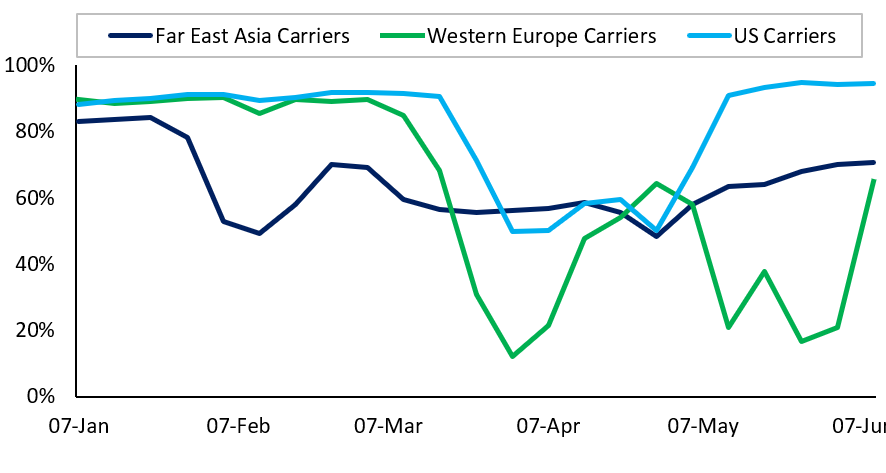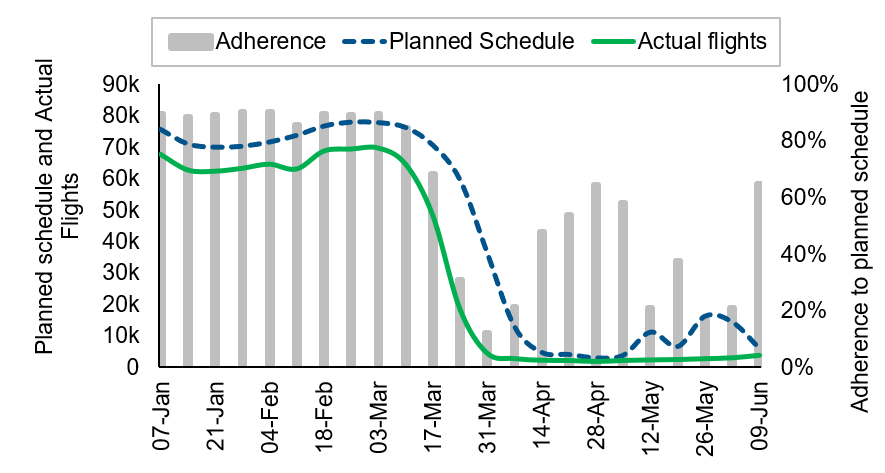Schedule vs. Reality: The gap between published schedules and airline operations

The global aviation industry remains in turmoil, continually challenging commercial airlines as they plan and publish their advanced schedules. This is made particularly difficult by the different lockdown rules and travel advice for each country, and the frequency with which these restrictions change – sometimes with as little as 6 hours warning. As a result, throughout the pandemic the actual number of flights operated by many airlines has been very different from their published schedules. ICF explores this issue below.
Although the easing of lockdown measures in some countries and regions explains the slight rise in commercial flight activity, many obstacles remain for airlines navigating the gradual recovery of demand for air services. Significant uncertainty remains as infections continue to climb in many parts of the world, forcing governments to constantly update policies on quarantines, no-fly countries, and social distancing. The unclear willingness of passengers to fly further compounds the challenge.

ICF analysis shows there is a great disparity between actual operations and published schedules, with up to 88% of scheduled operations not operated. Several factors may explain the discrepancy. First, some services that were scheduled to resume were cancelled due to travel ban extensions at either the origin, destination, or both. Second, some countries may have had quarantine requirements imposed, which very likely discourages travelers from flying and leads to flight cancellations. Third, airlines may publish scheduled services at slot constrained airports that have not provided flexibility, mainly in Asia and Europe, but ultimately cancel the flights. Finally, the flexibility offered to passengers to change the date of advanced bookings free of charge likely impacts bookings and can contribute to flight cancellations.
In countries where Covid-19 cases have fallen significantly (e.g. China, South Korea and Japan), actual airline operations have been far below published schedules.
From the last week of January until the end of April Chinese carriers operated between 40%-60% of their scheduled flights. From the first week of May 2020, the adherence factor was in the middle 60% before Beijing stopped flights on June 11th due to new coronavirus cases emerging in the city.
South Korean carriers operated from 85% to 97% of the scheduled flights through mid-February 2020, and since then they have been flying between 50% to high 60% of the scheduled flights.
Finally, Japan shows the lowest adherence factor operating 18%-30% of scheduled flights from mid-April through mid-June. Japanese carriers were flying over 70% from January through end of March.

Whilst Western European countries have flattened the curve on Covid-19 cases, airlines have shown a large decrease in scheduled flights and an even greater decrease in the number of operated flights. During May, Western Europe carriers operated just 17% to 38% of the flights they published. During the first week of June, the adherence of actual flights versus schedule flights was 74% which may indicate a gradual return to stability.
The UK was one of the countries where carriers operated just 4% to 6% of the published flights during May 2020. Carriers in Spain, Germany, Italy, and France showed the greatest differences between scheduled service and actual operations during March and recovered to hold an adherence factor of at least 55% since May.

Interestingly, US carriers are more in line with what they published in their schedules since May 2020. During April 2020, the adherence factor went as low as 50% for three weeks, but U.S. carriers have supported service to levels as required by the US Department of Transportation (DOT) to receive funding through the Coronavirus Aid, Recovery, and Economic Security Act (CARES Act).
Airlines around the world have struggled to manage an operation faithful to their published schedules since COVID-19 began impacting flights in March. Extended travel bans and changing restrictions on short notice continue to challenge air carriers as they attempt to manage their scheduling.
As travel restrictions are eased and travelers become accustomed to the new public health-oriented travel policies, published schedules should become more aligned with actual flight operations.
